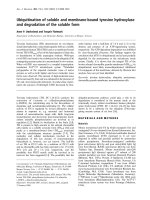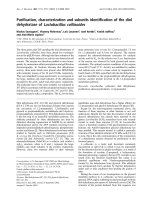Báo cáo y học: "Alpha-2 adrenoceptor agonists and sepsis: improved survival" ppt
Bạn đang xem bản rút gọn của tài liệu. Xem và tải ngay bản đầy đủ của tài liệu tại đây (114.09 KB, 2 trang )
Dr Pandharipande and colleagues should be com-
mended for segregating the eff ect of dexmedetomidine,
an alpha-2 adrenoceptor agonist, in sepsis [1]. However,
three questions arise from their study: what are the P-
values for the data reported in Table 1? Why was there
such a discrepancy between the fentanyl dose given to
patients on dexmedetomidine and those on lorazepam
(1,114 versus 117 μg/day, P = 0.01) considering the 50 to
80% reduction in the use of opiates commonly observed
in the literature when alpha-2 adrenoceptor agonists are
administered? And how many days did the patients spend
on spontaneous (for example, pressure support) versus
controlled/assisted ventilation?
In their study, survival was better (a 70% reduction in
risk of dying at 28 days) in patients on dexmedetomidine
(n = 31) than in those on lorazepam (n = 32). Improved
survival was observed earlier in tetanus patients [2] (rate
of death of 50% versus 11% in control (n = 10) versus
clonidine-treated (n = 17) patients; P = 0.04; this 1998
reference is not cited in the bibliography). In the study of
Dr Pandharipande and colleagues, baseline charac teristics
were slightly diff erent (Table 1 in [1]): tempera ture, heart/
respiratory rate, incidence of vaso pressors (dex-
medetomidine, 32%; lorazepam, 56%) and drotre co gin
alpha (activated; P = 0.20) were higher and systolic
pressure lower in the lorazepam group despite ‘similar
severity of illness’. Could bias explain partially improved
survival? As concluded by the authors [1], a larger trial
should demonstrate improved survival (for example,
upon septic shock [3]).
Secondly, the dexmedetomidine patients received ten
times more fentanyl and had more ventilator-free days.
Usually, alpha-2 adrenoceptor agonists reduce the need
for opiates by 50 to 80% and preserve spontaneous
ventilation. So why this discrepancy?
irdly, vasopressor requirements were reduced in the
dexmedetomidine group (Table 3 in [1]). A 2003 refer-
ence [4] showed previously a reduced vasopressor
require ment and was not cited in the bibliography. Could
more ventilator-free days lead to less infections [5,6],
improved survival, lowered intra thoracic pressure and
reduced vasopressor requirements?
© 2010 BioMed Central Ltd
Alpha-2 adrenoceptor agonists and sepsis:
improved survival?
Luc Quintin*
See related research by Pandharipande et al., />LETTER
*Correspondence:
Physiology (CNRS UMR 5123), University of Lyon, 69622 Lyon-Villeurbanne, France
Authors’ response
Pratik P Pandharipande,
Robert D Sanders,
Timothy D Girard,
Mervyn Maze and E Wesley Ely
Dr Quintin raises interesting questions regarding our
analyses of the septic subgroup in the MENDS trial [7],
which found improved outcomes and survival in septic
patients treated with dexmedetomidine versus
lorazepam [1]. In Table 1, we did not report P-values to
avoid mis leading readers into believing the groups were
perfectly balanced. Indeed, we advised caution when
interpreting these results since subgroup analyses are
prone to type II errors; that is, due to the reduced sample
sizes, some imbalances could have occurred that -
though not statis tically signifi cant - could have been
clinically important. We attempted, therefore, to reduce
the impact of potential imbalances by adjusting for age,
severity of illness and use of drotrecogin alfa.
Fentanyl was used both as an analgesic and supple-
mental sedative when a deeper level of sedation (than
that achieved with the study drug) was ordered by the
medical team. Higher doses of fentanyl were noted in
the dexmedetomidine group primarily when patients
were deeply sedated [7], suggesting the increased
fentanyl use refl ected a need for additional sedation
Quintin Critical Care 2010, 14:429
/>© 2010 BioMed Central Ltd
rather than analgesia. Previous studies reporting opioid-
sparing eff ects of dexmedetomidine have examined
intraopera tive use [8] or short-term use after surgery [9],
both of which involve diff erent populations than that
studied in MENDS.
We did not evaluate modes of ventilation. We did fi nd
an increase in ventilator-free days in septic patients
sedated with dexmedetomidine versus lorazepam, but
did not fi nd a reduction in secondary infections as seen
in SEDCOM [6]. us, our results do not support the
hypothesis that a reduced ventilator time in the septic
dexmedetomidine group resulted in lower secondary
infections and thereby improved survival.
Competing interests
PPP, TGD, MME and EWE received research grants and honoraria from Hospira
Inc. This is an investigator initiated study and Hospira Inc did not have a role
in the generation of the hypothesis, conduct of the trial, data analysis or
nancing of the manuscript.
PPP and EWE received honoraria from GSK; EWE received honoraria from
Aspect Medical and Eli Lily. None of these have any relevance to this
manuscript.
Acknowledgements
LQ received grants and honoraria from Bohringer-Ingelheim France, UCB
Pharma-Belgium, Abbott International (1986-95).
Published: 29 July 2010
References
1. Pandharipande PP, Sanders RD, Girard TD, McGrane S, Thompson JL, Shintani
AK, Herr DL, Maze M, Ely EW, Mends IT: E ect of dexmedetomidine versus
lorazepam on outcome in patients with sepsis: an a priori-designed
analysis of the MENDS randomized controlled trial. Crit Care 2010, 14:R38.
2. Gregorakos L, Kerezoudi E, Dimopoulos G, Thomaides T: Management of
blood pressure instability in severe tetanus: the use of clonidine. Intensive
Care Med 1997, 23:893-895.
3. Pichot C, Mathern P, Khettab F, Ghignone M, Geloen A, Quintin L: Increased
pressor response to noradrenaline during septic shock following
clonidine? Anesthesia Intensive Care (Sydney) 2010, in press.
4. Venn RM, Newman PJ, Grounds RM: A phase II study to evaluate the e cacy
of dexmedetomidine for sedation in the medical intensive care unit. Int
Care Med 2003, 29:201-207.
5. Spies CD, Dubisz N, Neumann T, Blum S, Muller C, Rommelspacher H,
Brummer G, Specht M, Sanft C, Hannemann L, Striebel HW, Scha artzik W:
Therapy of alcohol withdrawal syndrome in intensive care unit patients
following trauma: results of a prospective, randomized trial. Crit Care Med
1996, 24:414-422.
6. Riker RR, Shehabi Y, Bokesch PM, Ceraso D, Wisemandle W, Koura F, Whitten P,
Margolis BD, Byrne DW, Ely EW, Rocha MG: Dexmedetomidine vs midazolam
for sedation of critically ill patients: a randomized trial. JAMA 2009,
301:489-499.
7. Pandharipande PP, Pun BT, Herr DL, Maze M, Girard TD, Miller RR, Shintani AK,
Thompson JL, Jackson JC, Deppen SA, Stiles RA, Dittus RS, Bernard GR, Ely EW:
E ect of sedation with dexmedetomidine vs lorazepam on acute brain
dysfunction in mechanically ventilated patients: the MENDS randomized
controlled trial. JAMA 2007, 298:2644-2653.
8. Arain SR, Ruehlow RM, Uhrich TD, Ebert TJ: The e cacy of dexmedetomidine
versus morphine for postoperative analgesia after major inpatient
surgery. Anesth Analg 2004, 98:153-158.
9. Venn RM, Grounds RM: Comparison between dexmedetomidine and
propofol for sedation in the intensive care unit: patient and clinician
perceptions. Br J Anaesth 2001, 87:684-690.
doi:10.1186/cc9096
Cite this article as: Quintin L: Alpha-2 adrenoceptor agonists and sepsis:
improved survival? Critical Care 2010, 14:429.
Quintin Critical Care 2010, 14:429
/>Page 2 of 2









